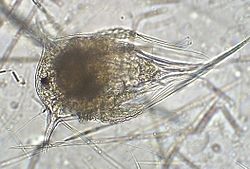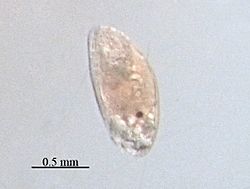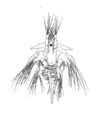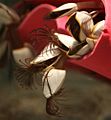Barnacle facts for kids
Quick facts for kids Barnacles |
|
|---|---|
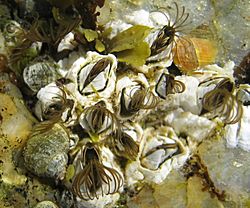 |
|
| Barnacles under water, showing the 'feet' in action | |
| Scientific classification | |
| Kingdom: | |
| Phylum: | |
| Subphylum: | |
| Class: | |
| Infraclass: |
Cirripedia
|
| Orders | |
|
|
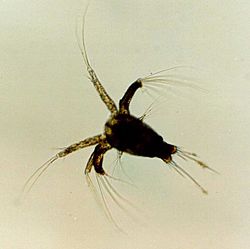
A barnacle is a cirripede, a kind of crustacean. It is covered with hard plates of calcium carbonate, and lives stuck to hard surfaces.
It does not look like a crustacean, and for many centuries it was thought to be a mollusc. In the 1830s, J.V. Thompson found their larvae, and followed their development through to their adult form. They have a nauplius larva, typical of crustaeans. Later Charles Darwin, who spent eight years working on barnacles, found that Thompson had been right.
Barnacles grow on hard surfaces like piers, boats, rocks, and on other animals such as turtles and whales. Barnacles are a different group from crabs and shrimps. They are considered a nuisance to the shipping industry and private boat owners.
Life-style
Barnacles are suspension feeders, sweeping small food into their mouth with their curved 'feet'. They are cemented to rock (usually), and covered with hard calcareous plates, which they shut firmly when the tide goes out. The barnacles reproduce sexually, and produce little nauplius larvae which disperse in the plankton. Eventually, the larvae change into cypris form, and attach on other hard surfaces to form new barnacles. Their comparative anatomy was worked out in detail by Charles Darwin.
Reproduction
A few forms have become fully parasitic on larger crustacea.
Barnacles are by far the commonest animals on rocky sea shores. Their numbers on a shore in the Isle of Man have been estimated as a thousand million (109), and they produce body material of 12 hundrededweight (~600 kg) of tissue, weighed after drying. Each year they let go a huge number of larvae, estimated as a million million (1012).
Darwin's work
Darwin set his work out in four parts: There were the barnacles on stalks (pedunculated), and those that sat on hard substrate (the sessile barnacles). Each of these was divided into living and fossil barnacles.
- 1851: A Monograph of the Sub-class Cirripedia, with figures of all the species. The Lepadidae; or, Pedunculated Cirripedes. Living barnacles.
- 1851: A Monograph on the Fossil Lepadidae, or, Pedunculated Cirripedes of Great Britain. Fossil barnacles.
- 1854: A Monograph of the Sub-class Cirripedia, with figures of all the species. The Balanidae (or Sessile Cirripedes); the Verrucidae, etc.
- 1854: A Monograph on the Fossil Balanidæ and Verrucidæ of Great Britain
Images for kids
-
Whale barnacles attached to the throat of a humpback whale
-
Nauplius larva of Elminius modestus
-
"Cirripedia" from Ernst Haeckel's Kunstformen der Natur (1904): The crab at the centre is nursing the externa of the parasitic cirripede Sacculina.
-
Barnacles and limpets compete for space in the intertidal zone
-
Underside of large Chesaconcavus sp. (Miocene) showing internal plates in bioimmured smaller barnacles
-
Balanus improvisus, one of the many barnacle taxa described by Charles Darwin
-
Miocene (Messinian) Megabalanus, smothered by sand and fossilised
-
Barnacles attached to pilings along the Siuslaw River in Oregon
-
Goose barnacles in a restaurant in Madrid
See also
 In Spanish: Cirrípedos para niños
In Spanish: Cirrípedos para niños


